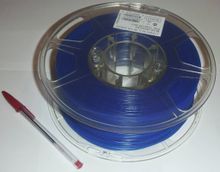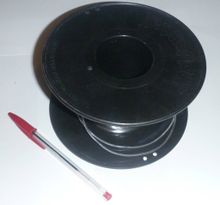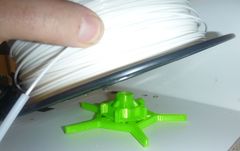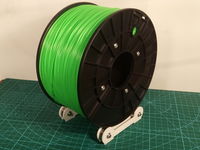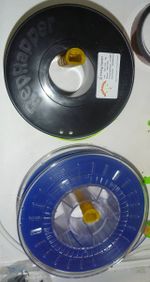Filament spool
Contents
Filament supply
Fused filament material is generally supplied in spools, carrying from 500g to 1kg filament. Larger spools for commercial use could be found, often with 4kg material.
There was distribution in open loops but this tend to disappear except for samples or costly specific filaments.
Some printer manufacturers supplied filament in proprietary cartridges, some of them having electronic chip to store data and usage. In consumer printer market, this faced some opposition.
The problem of spool is there is no dimension standard nor labelling.
Also, generally the usage indication on labels are vague, only indicating a range of temperature and speed, but no extrusion coefficient and no physical properties. Reference to applicable Health and Safety regulation is also quite rare.
Attempt of spool standardisation
In march 2014, RichRap made a web page to list all existing spools and make a detailed standard, also defining spool material. He updated this standard in november 2014. It was endorsed by The 3D printing association. This standard was discussed in forums but without support from filament and printer manufacturers, was never adopted.
Trends of dimensions for home use
Since this standardisation attempt, the range of spool size have decreased and there is a trend toward spools of 200mm diameter with a hole of 51-53mm, with hub diameter significantly larger than the spool hole diameter, from 85mm to 100mm. A large hub is required for some filament material like PLA which have problem to unwind from too small diameters and may break.
The spool width depends from the material quantity, typically 40mm for 500g of material, 54mm for 700g and 68mm for 1kg.
It shall be noted that as the density of material vary with material type, the same weight correspond to different volume and filament length for different materials (ABS:1.07 PLA:1.25 PETG:1.27 PET:1.38).
However, some manufacturers, as Taulman, still supply small diameter spools with small holes, making them difficult to install on most standard supports. They mostly supply flexible filament, which allow small hubs.
RepRapper, a Chinese manufacturer, is still using 155mm diameter spool, width 90mm with a hole 54mm , and a too small hub diameter of 58mm.
Also, some printer manufacturers allow limited place for spools, implying a rewinding of most filament. Flashforge Dreamer and Tiko could be cited, among others.
Standardisation for labelling
There is a project named "Universal Filament Identification System" - UFIS - which intend to define a standard data set , software and hardware to be implemented both on paper labels with QR-code and on RFID tags Example of the paper label could be found here
The community work on this project is here but seems somewhat idling (as of April 2016). QR code need a camera for recognition, but there are smartphone applications to read them, and it is feasible to transmit data from smartphone to printer via Wi-Fi, but this need another standard.
The cost of readers/writer and RFID labels have decreased significantly and it may be easier to use a RFID label, including the inscription on the RFID label by the printer of the data usage (length used).
Spool supports
You will find available on Internet a large quantity of designs. They could be divided in a few categories
Spool installed with vertical axis
Used for aesthetic reasons or specific setups, they need a brake to properly operate, as filament loops tend to cross while falling and make knots
- Spool running on bearings - not easily compatible with all diameters
- Spool on rotating supports - need adaptation rings to adapt to hole diameters. May not be compatible with small hole diameters
Spool installed with horizontal axis
- Spool running on bearings - need adaptation for different spool widths asUniversal spool stand
- Spool on rotating supports - need a set of support
- Spool on simple spigots - no adaptation, simple, reliable and versatile
See also
- Managing your filament
- ZemcikO spool holder Large spool holder - horizontal axis
- TechZone Horizontal Filament Spool For filament delivered loose - vertical axis
- Huxley mini-spool For filament delivered loose
- Filament Spindle For filament delivered loose
.
.
In addition to site licence GFDL1.2, this page is also released under license CC BY-SA 4.0
